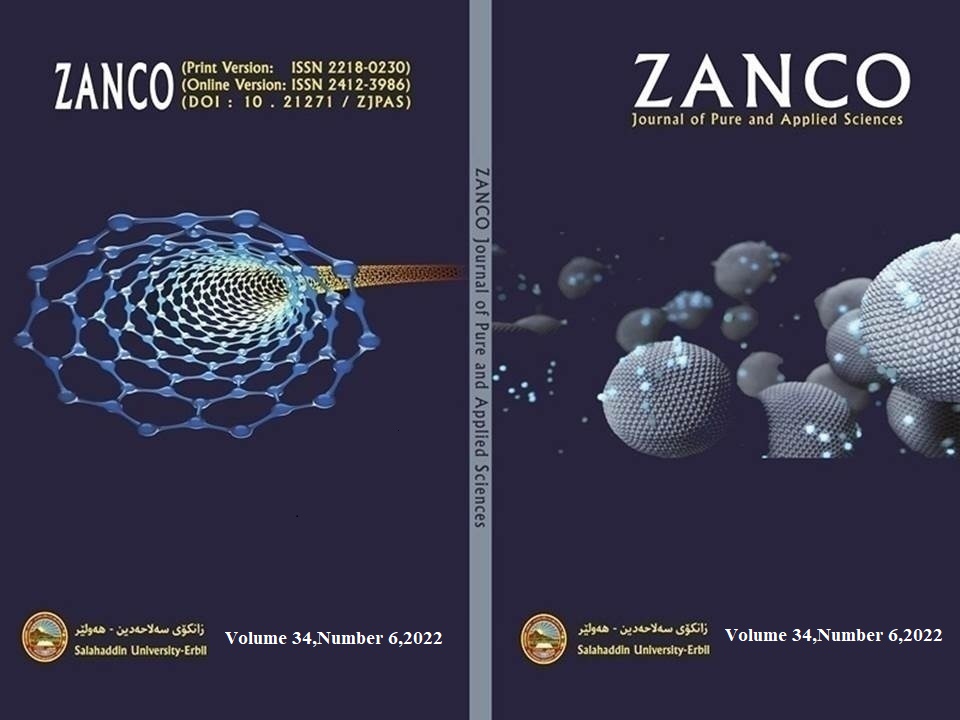Kinetic studies of copper-catalyzed homocoupling reactions of arylboronic acids in aqueous micellar media
DOI:
https://doi.org/10.21271/ZJPAS.34.6.21Keywords:
homocoupling, phenylboronic acids, biphenyls, cetyl trimethyl ammonium bromide (CTAB)Abstract
The kinetic studies for copper-catalyzed homocoupling phenylboronic acids (1a-d) have been successfully carried out in an aqueous micellar medium under environmentally benign conditions (water as a solvent, micelle to help solubilize hydrophobic adducts) in this study cetyl trimethyl ammonium bromide (CTAB ) is used as surfactant to produce micelle. Using different copper salts and copper complexes as catalysts under benign to mild conditions at a temperature range (40-65˚C, under air) without the addition of any additives (base, oxidant, and ligands). The reactions were followed using a UV-Vis spectrophotometer and the absorbances were measured at maximum wavelengths for the biphenyl production of each five selected (1a-d). The observed rate constants (kobs) were calculated using a pseudo-first-order equation and unsubstituted 1a was selected for optimization processes. The experimental results showed good to excellent curve fit (R2=0.9967-0.9998) to the pseudo-first-order equation and origin software was used for this purpose. Among all copper catalysts, the observed rate constant (kobs) for cupric acetate (Cu(OAc)2)is much higher than others, (kobs=0.1605 min-1), while CuCl2.2H2O has a minimum observed rate constant, kobs=0.0216min-1. The two copper complexes [Cu(4-mba)2(tmeda)], and [Cu(3-mba)2(H2O)2(tmeda)] require a mild condition (85˚C) which is higher than other copper catalysts when 1a is used as reactant the value of kobs is (0.0176, 0.0343 min-1) respectively, while using p-tolylboronic acid (1b) as reactant the value of kobs is (0.0173, 0.0147 min-1) respectively.
References
AMATORE, C., CAMMOUN, C. & JUTAND, A. 2008. Pd (OAc) 2/p‐Benzoquinone‐Catalyzed Anaerobic Electrooxidative Homocoupling of Arylboronic Acids, Arylboronates and Aryltrifluoroborates in DMF and/or Water. Wiley Online Library.
ATKINS, P., ATKINS, P. W. & DE PAULA, J. 2014. Atkins' physical chemistry, Oxford university press.
BASNET, P., THAPA, S., DICKIE, D. A. & GIRI, R. 2016. The copper-catalysed Suzuki–Miyaura coupling of alkylboron reagents: disproportionation of anionic (alkyl)(alkoxy) borates to anionic dialkylborates prior to transmetalation. Chemical Communications, 52, 11072-11075.
BOULEGHLIMAT, A., OTHMAN, M. A., LAGRAVE, L. V., MATSUZAWA, S., NAKAMURA, Y., FUJII, S. & BUURMA, N. J. 2017. Halide-enhanced catalytic activity of palladium nanoparticles comes at the expense of catalyst recovery. Catalysts, 7, 280.
BURNS, M. J., FAIRLAMB, I. J., KAPDI, A. R., SEHNAL, P. & TAYLOR, R. J. 2007. Simple Palladium (II) Precatalyst for Suzuki− Miyaura Couplings: Efficient Reactions of Benzylic, Aryl, Heteroaryl, and Vinyl Coupling Partners. Organic letters, 9, 5397-5400.
BUURMA, N. J. 2009. Kinetic medium effects on organic reactions in aqueous colloidal solutions. Advances in Physical Organic Chemistry, 43, 1-37.
CAO, Y.-N., TIAN, X.-C., CHEN, X.-X., YAO, Y.-X., GAO, F. & ZHOU, X.-L. 2017. Rapid Ligand-Free Base-Accelerated Copper-Catalyzed Homocoupling Reaction of Arylboronic Acids. Synlett, 28, 601-606.
CHENG, G. & LUO, M. 2011. Homocoupling of arylboronic acids catalyzed by CuCl in air at room temperature. Wiley Online Library.
CHENG, K., XIN, B. & ZHANG, Y. 2007. The Pd (OAc) 2-catalyzed homocoupling of arylboronic acids in water and ionic liquid. Journal of Molecular Catalysis A: Chemical, 273, 240-243.
CICCO, S. R., FARINOLA, G. M., MARTINELLI, C., NASO, F. & TIECCO, M. 2010. Pd‐Promoted Homocoupling Reactions of Unsaturated Silanes in Aqueous Micelles. Wiley Online Library.
CORBET, J.-P. & MIGNANI, G. 2006. Selected patented cross-coupling reaction technologies. Chemical reviews, 106, 2651-2710.
DAR, B. A., SINGH, S., PANDEY, N., SINGH, A., SHARMA, P., LAZAR, A., SHARMA, M., VISHWAKARMA, R. A. & SINGH, B. 2014. Clay encapsulated Cu (OH) x promoted homocoupling of arylboronic acids: An efficient and eco-friendly protocol. Applied Catalysis A: General, 470, 232-238.
DEMIR, A. S., REIS, Ö. & EMRULLAHOGLU, M. 2003. Role of copper species in the oxidative dimerization of arylboronic acids: Synthesis of symmetrical biaryls. The Journal of organic chemistry, 68, 10130-10134.
GALLON, B. J., KOJIMA, R. W., KANER, R. B. & DIACONESCU, P. L. 2007. Palladium nanoparticles supported on polyaniline nanofibers as a semi‐heterogeneous catalyst in water. Angewandte Chemie International Edition, 46, 7251-7254.
GRATZEL, M. 2020. Kinetics and catalysis in microheterogeneous systems, CRC Press.
HORTON, D. A., BOURNE, G. T. & SMYTHE, M. L. 2003. The combinatorial synthesis of bicyclic privileged structures or privileged substructures. Chemical reviews, 103, 893-930.
JIN, Z., GUO, S. X., GU, X. P., QIU, L. L., SONG, H. B. & FANG, J. X. 2009. Highly Active, Well‐Defined (Cyclopentadiene)(N‐heterocyclic carbene) palladium Chloride Complexes for Room‐Temperature Suzuki–Miyaura and Buchwald–Hartwig Cross‐Coupling Reactions of Aryl Chlorides and Deboronation Homocoupling of Arylboronic Acids. Advanced Synthesis & Catalysis, 351, 1575-1585.
KABALKA, G. W. & WANG, L. 2002. Ligandless palladium chloride-catalyzed homo-coupling of arylboronic acids in aqueous media. Tetrahedron letters, 43, 3067-3068.
KABOUDIN, B., ABEDI, Y. & YOKOMATSU, T. 2011a. CuII–β‐Cyclodextrin Complex as a Nanocatalyst for the Homo‐and Cross‐Coupling of Arylboronic Acids under Ligand‐and Base‐Free Conditions in Air: Chemoselective Cross‐Coupling of Arylboronic Acids in Water. Wiley Online Library.
KABOUDIN, B., HARUKI, T. & YOKOMATSU, T. 2011b. CuSO4-mediated homocoupling of arylboronic acids under ligand-and base-free conditions in air. Synthesis, 2011, 91-96.
KANSıZ, S., QADIR, A. M., DEGE, N. & FAIZI, S. H. 2021. Two new copper (II) carboxylate complexes based on N, N, N', N'-tetramethylethyleneamine: Synthesis, crystal structures, spectral properties, dft studies and hirshfeld surface analysis. Journal of Molecular Structure, 1230, 129916.
KARIMI, B. & AKHAVAN, P. F. 2009. Main-chain NHC-palladium polymer as a recyclable self-supported catalyst in the Suzuki–Miyaura coupling of aryl chlorides in water. Chemical communications, 3750-3752.
KHALILY, M. A., USTAHUSEYIN, O., GARIFULLIN, R., GENC, R. & GULER, M. O. 2012. A supramolecular peptide nanofiber templated Pd nanocatalyst for efficient Suzuki coupling reactions under aqueous conditions. Chemical Communications, 48, 11358-11360.
KIRAI, N. & YAMAMOTO, Y. 2009. Homocoupling of Arylboronic Acids Catalyzed by 1, 10‐Phenanthroline‐Ligated Copper Complexes in Air. Wiley Online Library.
KLINGENSMITH, L. M. & LEADBEATER, N. E. 2003. Ligand-free palladium catalysis of aryl coupling reactions facilitated by grinding. Tetrahedron letters, 44, 765-768.
LIU, M. & LI, C. J. 2016. Catalytic Fehling's reaction: an efficient aerobic oxidation of aldehyde catalyzed by copper in water. Angewandte Chemie, 128, 10964-10968.
LLOYD-WILLIAMS, P. & GIRALT, E. 2001. Atropisomerism, biphenyls and the Suzuki coupling: peptide antibioticsAbbreviations: Bn= benzyl; Boc= tert-butoxycarbonyl; dba= dibenzylideneacetone; Ddm= 4, 4′-dimethoxydiphenylmethyl; DMSO= dimethylsulfoxide; FDPP= pentafluorophenyl diphenylphosphinate; MEM= methoxyethoxymethyl; Ms= methylsulfonyl; Piv= pivaloyl; TBS= tert-butyldimethylsilyl; Tf= trifluoromethanesulfonyl; Tfa= trifluoroacetyl; TFA= trifluoroacetic acid; Z= benzoxycarbonyl. Chemical Society Reviews, 30, 145-157.
MARIN, G. 2011. G. Yablonsky'Kinetics of Complex Reactions. Decoding Complexity'. J. Wiley-VCH.
MARION, N., NAVARRO, O., MEI, J., STEVENS, E. D., SCOTT, N. M. & NOLAN, S. P. 2006. Modified (NHC) Pd (allyl) Cl (NHC= N-heterocyclic carbene) complexes for room-temperature Suzuki− Miyaura and Buchwald− Hartwig reactions. Journal of the American Chemical Society, 128, 4101-4111.
MARTIN, R. & BUCHWALD, S. L. 2008. Palladium-catalyzed Suzuki− Miyaura cross-coupling reactions employing dialkylbiaryl phosphine ligands. Accounts of chemical research, 41, 1461-1473.
MCGLACKEN, G. P. & BATEMAN, L. M. 2009. Recent advances in aryl–aryl bond formation by direct arylation. Chemical Society Reviews, 38, 2447-2464.
MITSUDO, K., SHIRAGA, T., KAGEN, D., SHI, D., BECKER, J. Y. & TANAKA, H. 2009. Pd/TEMPO-catalyzed electrooxidative synthesis of biaryls from arylboronic acids or arylboronic esters. Tetrahedron, 65, 8384-8388.
MITSUDO, K., SHIRAGA, T. & TANAKA, H. 2008. Electrooxidative homo-coupling of arylboronic acids catalyzed by electrogenerated cationic palladium catalysts. Tetrahedron Letters, 49, 6593-6595.
MIYAURA, N. & SUZUKI, A. 1995. Palladium-catalyzed cross-coupling reactions of organoboron compounds. Chemical reviews, 95, 2457-2483.
MONNIER, F. & TAILLEFER, M. 2009. Catalytic C C, C N, and C O Ullmann‐Type Coupling Reactions. Angewandte Chemie International Edition, 48, 6954-6971.
MU, B., LI, T., FU, Z. & WU, Y. 2009. Cyclopalladated ferrocenylimines catalyzed-homocoupling reaction of arylboronic acids in aqueous solvents at room temperature under ambient atmosphere. Catalysis Communications, 10, 1497-1501.
OTHMAN, M. A. 2011. Palladium-catalysed aerobic oxidative homocoupling reaction of arylboronic acids in aqueous micellar medium: Kinetic and mechanistic studies, Cardiff University (United Kingdom).
OTHMAN, M. A. 2020. Stability of Palladium (II) beta-cyclodextrin nanocomposite in aqueous media and its catalytic activity in Homocoupling of Arylboronic acid. Zanco Journal of Pure and Applied Sciences, 32, 114-121.
PARRISH, J. P., JUNG, Y. C., FLOYD, R. J. & JUNG, K. W. 2002. Oxidative dimerization: Pd (II) catalysis in the presence of oxygen using aqueous media. Tetrahedron letters, 43, 7899-7902.
PARSHAMONI, S., TELANGAE, J., SANDA, S. & KONAR, S. 2016. A Copper‐Based Metal–Organic Framework Acts as a Bifunctional Catalyst for the Homocoupling of Arylboronic Acids and Epoxidation of Olefins. Chemistry–An Asian Journal, 11, 540-547.
POURMORTEZA, N., JAFARPOUR, M., FEIZPOUR, F. & REZAEIFARD, A. 2022. Cu (ii)–vitamin C-complex catalyzed photo-induced homocoupling reaction of aryl boronic acid in base-free and visible light conditions. RSC advances, 12, 4931-4938.
PRASTARO, A., CECI, P., CHIANCONE, E., BOFFI, A., CIRILLI, R., COLONE, M., FABRIZI, G., STRINGARO, A. & CACCHI, S. 2009. Suzuki-Miyaura cross-coupling catalyzed by protein-stabilized palladium nanoparticles under aerobic conditions in water: application to a one-pot chemoenzymatic enantioselective synthesis of chiral biaryl alcohols. Green Chemistry, 11, 1929-1932.
PRASTARO, A., CECI, P., CHIANCONE, E., BOFFI, A., FABRIZI, G. & CACCHI, S. 2010. Homocoupling of arylboronic acids and potassium aryltrifluoroborates catalyzed by protein-stabilized palladium nanoparticles under air in water. Tetrahedron Letters, 51, 2550-2552.
PUTHIARAJ, P., SURESH, P. & PITCHUMANI, K. 2014. Aerobic homocoupling of arylboronic acids catalysed by copper terephthalate metal–organic frameworks. Green Chemistry, 16, 2865-2875.
RAUL, P. K., MAHANTA, A., BORA, U., THAKUR, A. J. & VEER, V. 2015. In water homocoupling of arylboronic acids using nano-rod shaped and reusable copper oxide (II) catalyst at room temperature. Tetrahedron letters, 56, 7069-7073.
SCRIMIN, P., TECILLA, P., TONELLATO, U. & BUNTON, C. A. 1998. Nucleophilic catalysis of hydrolyses of phosphate and carboxylate esters by metallomicelles: facts and misconceptions. Colloids and Surfaces A: Physicochemical and Engineering Aspects, 144, 71-79.
SMITH, M. B. 2020. March's advanced organic chemistry: reactions, mechanisms, and structure, John Wiley & Sons.
VAN OS, N. M., HAAK, J. R. & RUPERT, L. A. M. 2012. Physico-chemical properties of selected anionic, cationic and nonionic surfactants, Elsevier.
WONG, M. S. & ZHANG, X. L. 2001. Ligand promoted palladium-catalyzed homo-coupling of arylboronic acids. Tetrahedron Letters, 42, 4087-4089.
YADAV, J. S., GAYATHRI, K. U., ATHER, H., UR REHMAN, H. & PRASAD, A. R. 2007. Utility of semicarbazones as ligands in newly made palladium complex for facile Suzuki homocoupling reaction of alkyl and aryl boronic acids. Journal of Molecular Catalysis A: Chemical, 271, 25-27.
YAMAMOTO, Y. 2007. Homocoupling of arylboronic acids with a catalyst system consisting of a palladium (II) N-heterocyclic carbene complex and p-benzoquinone. Synlett, 2007, 1913-1916.
YAMAMOTO, Y., SUZUKI, R., HATTORI, K. & NISHIYAMA, H. 2006. Base-and phosphine-free palladium-catalyzed homocoupling of arylboronic acid derivatives under air. Synlett, 2006, 1027-1030.
YANG, X.-F., ZHANG, L.-L. & ZHU, H.-B. 2021a. Size-Selective Homocoupling of Arylboronic Acids Mediated by a Copper-Based Metal–Organic-Framework. Journal of Inorganic and Organometallic Polymers and Materials, 31, 4623-4627.
YANG, X.-F., ZHANG, L.-L. & ZHU, H.-B. 2021b. Size-Selective Homocoupling of Arylboronic Acids Mediated by a Copper-Based Metal–Organic-Framework. Journal of Inorganic and Organometallic Polymers and Materials, 1-5.
YUAN, C., ZHENG, L. & ZHAO, Y. 2019. Cu (II)-Catalyzed Homocouplings of (Hetero) Arylboronic Acids with the Assistance of 2-O-Methyl-d-Glucopyranose. Molecules, 24, 3678.
ZHOU, L., XU, Q. X. & JIANG, H. F. 2007. Palladium-catalyzed homo-coupling of boronic acids with supported reagents in supercritical carbon dioxide. Chinese Chemical Letters, 18, 1043-1046.
Downloads
Published
How to Cite
Issue
Section
License
Copyright (c) 2023 Hawta K. Abdullah, Mazin A. Othman

This work is licensed under a Creative Commons Attribution 4.0 International License.














